October 31, 2023—In the world of medical aesthetics, the saying “A picture is worth a thousand words” rings particularly true.
As a provider, you might be a master of your craft, but if you’re unsure how to effectively showcase your results with high-quality before and after images (B&As), you may not reach your desired level of success, says Philadelphia-based plastic surgeon Dr. Christian Subbio.
Well-known on Instagram for his entertaining and educational posts, Dr. Subbio emphasized the importance of advertising your practice with high-quality B&As during his talk at Sciton’s New York City Rockstar Experience event in October.
“There is too much content on social that everybody has already seen. Be harshly critical of your social posts,” he advised Rockstar guests. “Instagram demands perfection. Aim high.”
Consider the impact of visuals in the digital world
Hubspot.com research reveals that Facebook posts featuring photos secure not only 53% more likes but also a staggering 104% more comments compared to posts devoid of visuals.1
Furthermore, a study conducted by researchers at Georgia Tech sheds light on the appeal of faces in photos. Their findings indicate that images with faces are 38% more likely to receive likes and 32% more likely to garner comments when compared to faceless images. Notably, factors like age, gender, and the number of faces in the image did not significantly influence these trends—simply having a face in the picture was enough to appeal to more viewers.2
Moreover, insights from the Cosmetic Surgery on Social Media survey by the American Society of Plastic Surgeons (ASPS) emphasize the importance of visual content. Social media users desire before-and-after photos, comprehensive treatment information, and videos of procedures in action.3
In today’s digital landscape, your photo gallery on your website and the images you share on social media play a pivotal role in attracting patients to your practice.
Read on for 11 tips to enhance your practice’s visibility, generate leads, and ultimately convert prospects into satisfied patients through incorporating B&As in your marketing.
But first, the benefits to posting B&A’s
Before we delve into tips for creating compelling B&As, it’s important to understand why these visuals are integral to your aesthetic practice.
Build trust. Trust is a cornerstone of patient-provider relationships. B&As are an effective tool for establishing trust, as people tend to rely more on pictures than words, especially when it comes to showcasing the results of cosmetic procedures. A RealSelf.com survey by the Harris Poll found that 53% of clients consider before and after photos as the most valuable resource when selecting an aesthetic provider.4 Another RealSelf survey revealed that a substantial 83% of individuals researching aesthetic procedures would not consider a practice without B&A images.5
Increase credibility. For practices that capture their own patient photography, B&As significantly enhance credibility. High-quality, authentic B&As that accurately represent a patient’s transformation over multiple visits are particularly impactful.
Generate leads. B&As serve as a vital marketing tool for converting social media and website visitors into patients. Most prospective patients want to see actual results before scheduling a treatment. According to an RXPhoto survey involving over 1000 customers, 42.9% expressed a keen interest in a medical practice’s B&A gallery when searching for cosmetic procedures, ranking it just behind customer reviews and testimonials. Furthermore, when asked if they would consider a medical practice for a cosmetic procedure without a B&A gallery on their website, a substantial 74.8% stated they would not. 6
B&A images not only build trust and credibility but also play a pivotal role in converting prospects into patients and generating a loyal following.
Tip #1: Tailor your B&As to match your target demographic
Your B&A gallery should align with the patient demographic you’re aiming to reach. Here’s why this matters.
Cultivate relatability. When potential patients view your images, they should be able to see themselves represented in terms of ethnicity, age, and gender. If they can’t identify with the patients you’re presenting in your B&As, they’re less likely to consider becoming customers.
To maximize the impact of your B&As, consider showing patients images of others with similar characteristics, such as skin type, lip shape, or types of tattoos, says Loretta Zanetti and Kristen Capo from Erasable Med Spa in Tampa, FL. 7
An industry survey by New Beauty magazine found that 60% of patients value B&A photos of individuals who resemble them, along with providers experienced in treating such patients, stating, “The two most important factors in choosing a provider was having before and after photos of patients that look like me and providers having experience with patients that look like me.” 7
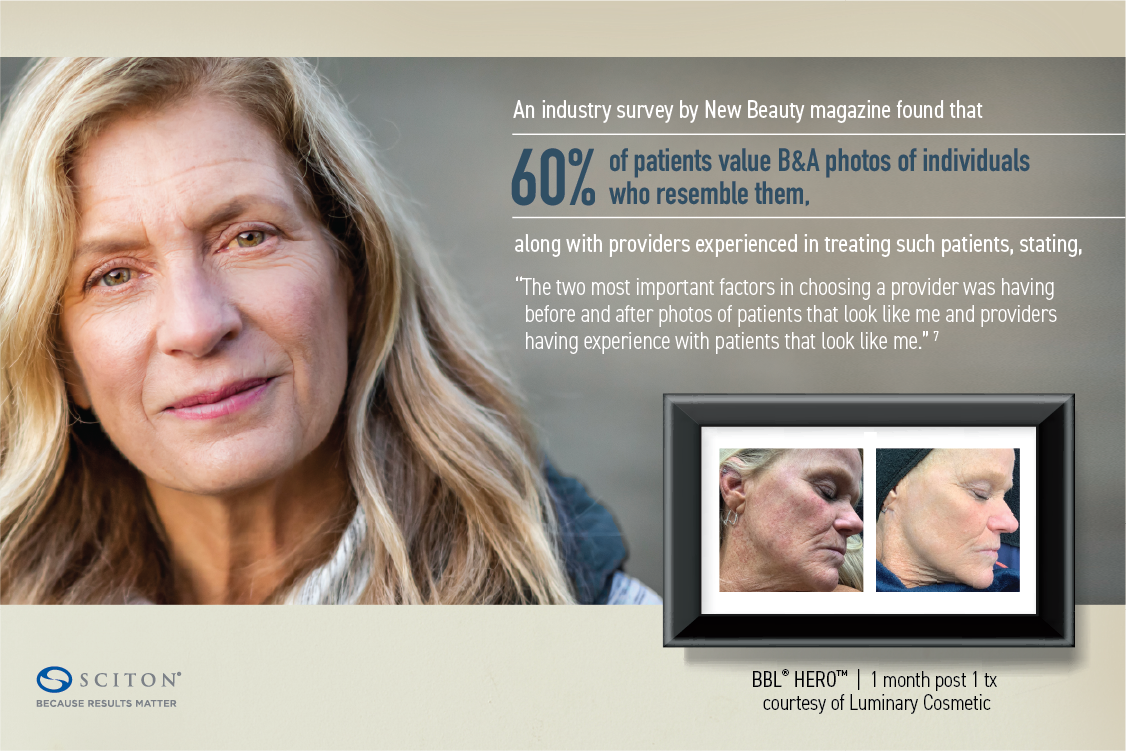
In an AARP Survey of Women’s Reflections on Beauty, Age, and Media™, 58 percent of women ages 21 to 72 say they are more likely to purchase products from brands that use models who look like them in their advertising. 7
“The results of this survey confirm something we’ve suspected all along, says AARP Senior Vice President and Editorial Director Myrna Blyth, “Women want to see themselves reflected in advertising and other types of media in authentic ways, and they’re more likely to buy products from advertisers who use images of women who are a variety of ages.” 8
Cater to evolving patient demographics. It’s essential to stay informed about the evolving trends around patients seeking aesthetic procedures. For instance, consider the increasing number of millennials opting for cosmetic treatments and the growing interest from men.9
Be aware of changing trends. As the marketing landscape expands beyond traditional gender norms, you may also consider using images of men and women who don’t conform to ultra-masculine or feminine ideals if this is in line with your patient demographic. This approach reflects the changing attitudes and preferences of modern consumers and showcases a more inclusive and diverse range of beauty standards.10
By posting B&As that your patient population can relate to, you create a visual narrative that resonates deeply with your patient base and fosters a sense of connection and trust that can significantly boost your practice’s appeal and patient conversion rates.
Tip #2: Spotlight the most common skin conditions
Understanding the specific skin conditions that your patients commonly seek treatment for is pivotal. Showcase these concerns through compelling B&A images across various platforms, including your website, social, and print ads, to maximize your reach and impact. Here are some prevalent skin conditions to feature in your B&A gallery:
- Acne and Acne Scars
- Wrinkles
- Photo Damage
- Melasma
- Brown Spots/Pigmented Lesions
- Vascular Lesions
- Rosacea
- Poikiloderma and Telangiectasia
- Onychomycosis
- Unwanted Fat
- Tattoo Removal
Including B&A images of these conditions helps prospective patients visualize the results they can achieve and encourages them to take the next step toward seeking your services.
Check out Sciton’s Instagram for high-quality B&As, treatment videos, and more.
Tip #3: Include detailed treatment information with your B&A photos
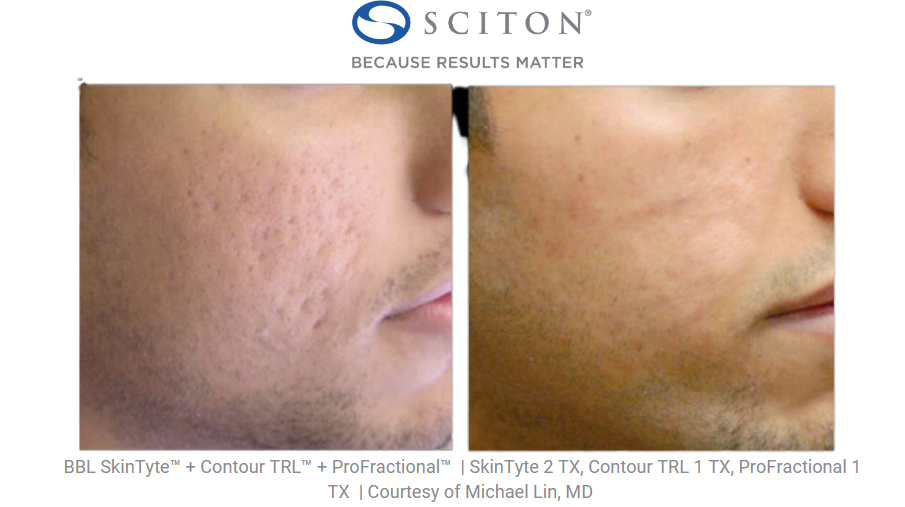
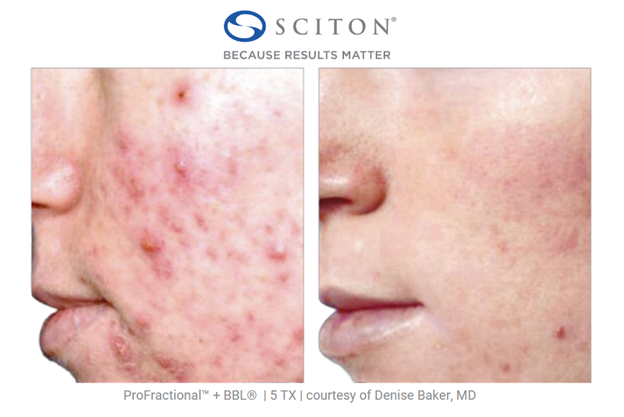
When sharing B&A images, provide comprehensive details to give your audience a deeper understanding of the results and how they were achieved. Consider including the following information:
Names of treatments. Specify the treatments utilized to achieve your results. This not only educates your audience but also demonstrates your expertise in combining different modalities for optimal outcomes.
Number of sessions. Share how many treatment sessions were required to reach the desired results. This information helps set realistic expectations for potential patients.
Time between photos. Indicate the time elapsed between the “before” and “after” photos. This timeline offers transparency and reinforces the notion that these transformations may occur gradually and with more than one treatment session.
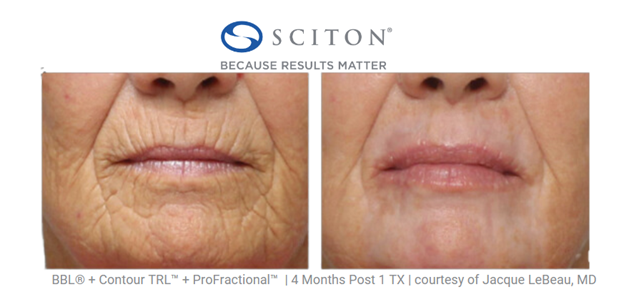
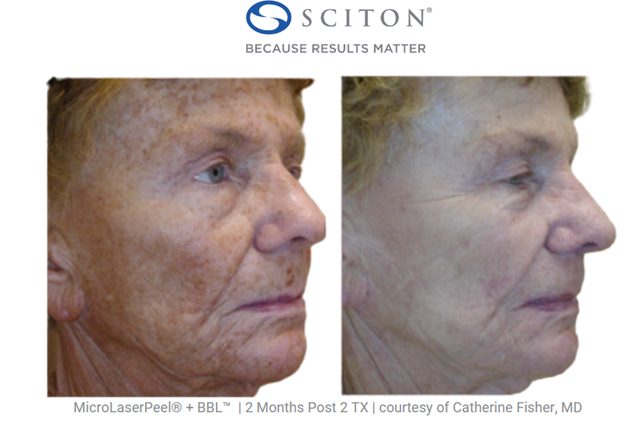
Tip #4: Embrace B&As that offer subtle changes
Modern consumers are increasingly drawn to minimally invasive treatments that yield subtle and gradual enhancements, often referred to as ‘tweakments.’ These procedures, which include skin polishing treatments like the MOXI laser, minimally invasive lip enhancements, and nose-shaping treatments, cater to individuals seeking slight yet noticeable adjustments in their appearance without the commitment of more drastic alterations.
This trend aligns with the current shift towards open-mindedness and creativity in the beauty industry, particularly among the Gen Z demographic. Patients today are exploring options that provide the flexibility to adapt their look as desired.10
As you curate your B&A portfolio, don’t shy away from showcasing these subtle transformations. They appeal to a growing segment of the market and reflect the evolving preferences in the realm of aesthetics. This forward-thinking approach positions your practice as one that is in tune with the shifting beauty landscape. 10
Tip #5: Ensure consistency in your photography
To maintain consistency in your B&A images, keep the lighting, background, distance, and angle selection uniform. 11
By following these tips, you’ll create B&A images that offer a true reflection of your clients’ transformations and convey the professionalism of your practice.
Lighting. Consistent, even lighting with no shadows is crucial for accurate representations. Natural light is ideal, but keep in mind that harsh sunlight or bright artificial lighting can oversaturate skin tones. Consider using photo settings to adjust the brightness and contrast automatically. Dr. Subbio suggests using a ring light or three-point lighting setup to enhance photo quality. Ring lights are convenient and space-effective, providing well-lit images.
Background. Opt for a blue, gray, or black background or use apps like Canva to remove the background for a consistent look. Consider a collapsible backdrop or a cloth backdrop between two poles for easy storage when not in use.
Distance. Mark a floor position or use a floor mat for patients to stand on, ensuring a consistent distance for all photos. Dr. Subbio recommends capturing photos from a distance and cropping them for the best results.
Angle selection. Choose an angle that complements your treatment area. There are three fundamental angles. The initial angle is the head-on shot, capturing your subject directly from the front. The next angle to consider is the side-profile shot, where you position yourself so that your shoulders are perpendicular to the subject’s position. You also have the three-quarter angle, where you stand midway between the head-on and side-profile positions. In cases where your shooting area doesn’t provide enough space to move around your subject for different angles, you can have the subject rotate in place to achieve similar results. This approach allows you to capture diverse perspectives without requiring a wide shooting area.
Camera height. The camera’s height should match the treatment. For facial work, aim at the face; for full-body shots, position it near the breast line. Always keep the camera parallel to the ground to avoid distorting the patient’s appearance.
When capturing after photos, use the same camera settings, angle, lighting, and distance for an accurate representation of your client’s results.
Bonus tip: If space allows, designate an exam room as a photo studio. Invest in professional lighting and photographic equipment and ensure consistent lighting by closing windows and blinds for reproducible results. 11
Tip #6: Select the right equipment
Your choice of equipment can make a big impact when capturing B&As. Consider the following equipment options:
Smartphones. According to Dr. Subio, an iPhone 14 (or higher) can effectively capture B&As with the right camera settings. Ensure your phone’s camera has a high resolution, ideally at least 12 megapixels. This is often sufficient for general purposes.
Single-lens reflex camera (SLR). SLR cameras with a 105mm lens are optimal for capturing subtle improvements. Any camera equipped with this lens can work well. SLR cameras provide a wide range of settings and versatility, making them a preferred choice for professionals.
Macro lens. For detailed close-ups of skin treatments, particularly when you need to showcase intricate details in skin pores, consider purchasing a macro lens for your camera. This specialized lens allows you to get close enough to highlight the nuances in your treatments.
The choice of equipment largely depends on your specific needs, budget, and level of expertise. Both smartphones and SLR cameras can produce exceptional results when used correctly, and the addition of a macro lens can take your close-up shots to the next level.
Tip #7: Keep it natural – avoid filters and over-editing
In professional clinical photography, the authenticity and accuracy of your B&A images are paramount.
While filters may be popular on social media platforms like Instagram, they have no place in professional clinical photography. The goal is to showcase genuine results, so any alterations or stylizing that could make the photos appear manipulated should be avoided.
Your primary aim is to present real, unaltered outcomes of your work. Filters and editing can distort the genuine results and create a misleading impression. It’s crucial to maintain transparency and integrity in your visual representations.
When presenting patients’ skin results, it is essential to capture photographs with minimal to no makeup in both the before and after images
Bonus tip: When it comes to photo editing, consider using photo editing apps like Snapseed, VSCO, and Hootsuite Photo Editor. 12 These tools can help you enhance your photos while preserving their authenticity and can be seamlessly integrated with your social media channels. This allows you to maintain a polished, professional appearance while delivering accurate depictions of your work.
By adhering to these guidelines, you’ll ensure that your B&A images remain consistent with the real results of your treatments, which is essential for building trust with your potential patients.
Tip #8: Get patient consent before posting B&As
Patient consent is not just a legal requirement but also an ethical consideration when sharing B&As.
Before sharing any patient images online, it’s essential to obtain written consent from the individuals involved. This written consent should be in the form of a signed release form that clearly outlines the patient’s decision to “opt in” or “opt out” of having their B&A photography shared online or on social media.
In many jurisdictions, obtaining written consent is a legal requirement. It safeguards you from potential legal complications and ensures you are in compliance with patient privacy regulations.
Tip #9: Protect your images with a watermark
In an era where digital content can be easily misappropriated, safeguarding your intellectual property is crucial. To protect your B&A images from potential theft and misuse, utilize watermarks, which could be your logo, on your B&A photos. This serves as a visual mark of ownership, making it difficult for others to pass these results off as their own. Watermarks are a practical and effective deterrent against unauthorized use.
Tip #10: Ensure easy access to your B&A gallery with a prominent link
In the digital landscape, ease of navigation and access to information is crucial. To help potential patients quickly find what they need and reduce the risk of them leaving your website for the competition, consider the following tips. 13
Feature a direct link. Prominently display a direct link to your B&A gallery on your website’s menu. This ensures that visitors can easily locate this valuable resource.13
Enhance user experience. Consider adding a call-to-action for the gallery just above the fold on your website’s main page. Additionally, when a visitor hovers over the ‘GALLERY’ option in the menu, provide a preview of which procedures have galleries available. This approach minimizes the number of clicks required to reach a viewer’s desired destination.
By implementing these practices, you create a user-friendly experience that keeps potential patients engaged and encourages them to explore your B&A gallery.
Tip #11: Enhance user experience with a zoom-in feature
To provide potential patients with a comprehensive view of your B&A images, do the following:
Incorporate a zoom-in capability. Ensure your B&A images offer a zoom-in feature that allows visitors to click on thumbnails and enlarge photos significantly. This functionality should permit them to see results clearly, ideally by 100% or more.
The Nielsen Norman Group has emphasized that the inability to enlarge photos is a significant web design mistake, even though the technology is readily available to website developers. Prioritizing this feature enhances user engagement and satisfaction.14
Including a zoom-in feature in your B&A gallery provides a more immersive and informative experience for potential patients. It allows them to thoroughly evaluate results and make informed decisions, improving the overall effectiveness of your aesthetic practice’s online presence.
Found these tips helpful?
Share the link with your friends or colleagues. Follow us on Instagram and LinkedIn to learn about product launches, updates, news, and more!
References
1Photos on Facebook Generate 53% More Likes Than the Average Post [NEW DATA]
2Experiment: Do Photos With People Perform Better on Instagram?
3Cosmetic Surgery on Social Media – Patients Rate Preferred Social Media Sites and Content
5Marketing Must-have: Great Before & After Photos
6What med spa owners need to know – before and after photos
7Sciton’s Concierge Connect Webinar
8AARP Survey Reveals Disconnect Between Images in Ads and Women’s Desire for Realism
9American Society of Plastic Surgeons, Plastic Surgery Statistics Report 2020
10The Future of Aesthetics Global Trends Report
11Tips for Creating Stunning and Accurate Before and After Photography
12How to Edit Instagram Photos Like a Pro
1311 rules to make your before and after gallery convert prospects to patients
